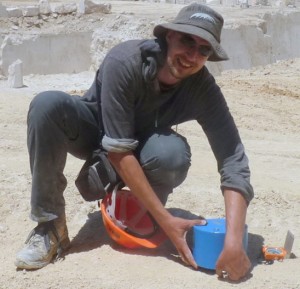With only 10 days left for the kick off of the annual European Geosciences Union General Assembly (2016), here is a quick-list to go through in time for EGU. Please note that the Austria Center Vienna has implemented a new system of room numbers and level names. The major changes can be found here.
First, read this page for information concerning activities for Early Career Scientists at the GA:
https://www.egu.eu/young-scientists/at-the-assembly/
Sunday 17th April: The Opening Reception, 18.30-21.00 in Foyer E.
Mingle and tingle with the crowd, old, not so old, and young scientists, all in one place. A perfect place for a cheer and networking. A gathering point for early career scientists provides the opportunity to meet like-minded fellows, especially if it is your first time at the General Assembly or you are coming alone.
EU2016 mobile app
The EGU2016 mobile app is now available for most smart phones. Go to http://app.egu2016.eu to download the app.
Short Courses
With an ever increasing number of short courses held at the GA, probably there is one good course for you. Many are held during breaks, purposely not to coincide with other sessions. The full list is here: http://meetingorganizer.copernicus.org/EGU2016/sessionprogramme/SC
Monday: Oral presentation feedback round
Find out how to improve your presentation skills on Monday, 18th April, 08:30–12:00 in Room -2.61, during a special session dedicated for Oral and PICO presentations.
Seismology Program
Tuesday – Thursday – Friday: Meet the EGU Division President of Seismology
Get a unique opportunity to meet with P. Martin Mai, the current president for the Seismology Division. You are invited to stop at the EGU booth to ask EGU related questions or discuss ways you would like EGU to improve. Martin will be available on Tuesday, Thursday, and Friday, 11:15–12:00 / Room EGU Booth
Medal Lectures
Get the opportunity to listen to world class experts in various geosciences. Medal Lectures are special sessions that give merit to distinguished scientists. They are usually followed by insightful (and thought provoking) presentations. These lectures are well attended and seats are quickly taken. View the full medal list here.
Note for seismologists: the Beno Gutenberg Medal Lecture by Roel Snieder on Wednesday, 15th April between 11:00–12:00 / Room K2.
Wednesday: Division Meeting for Seismology
In the Division Meeting for Seismology (SM), the division president will present the latest information on the state of the division, statistics for abstracts and sessions in 2016, and the news related to the various divisional activities. All members are invited, and encouraged to actively participate in the meeting. A Division Outstanding Young Scientist Award will be presented to Joseph Deutsch (ETH Zurich). Lunch is provided. Wed, 20 Apr, 12:15–13:15 / Room L2
Wednesday: EGU Early Career Scientists’ Forum
Are you an early career scientist at the General Assembly? Come along and meet your early career scientist representatives, find out what the EGU does for early career scientist and take the chance to become more involved in the Union. This forum is a great opportunity to let us know what you would like from the EGU, find out how you can get involved in the Assembly and meet other scientists in the EGU early career scientist community on Wednesday 20 Apr, 12:15–13:15 / Room L7
Wednesday: Recent activities of the Seismology Division Early Career Representative(s)
Do you have any comments/recommendations and/or concerns with regards to EGU and/or the Seismology Division? This is the right opportunity to share ideas with your representative(s). We highlight all Seismology activities on a poster that will be presented on Wednesday 20th April, 17:30-19:00 – at X1.322. Come over and let’s talk!
Thursday: Consider attending and registrating for our own Short Course: “Seismology for non-seismologists“ – Thursday 21th April, 12:15-13:15, Room -2.61. A dedicated short course directed to non-seismologists or early career seismologists, with a particular focus how to integrate seismology within your own research. Afterwards you can stay for ‘The Art of Being a Scientist’: A short course run by Roel Snieder – Beno Gutenberg medalist. This is a workshop for professionals wishing to perfect the practical skills needed for a successful research career. Thursday 21th April, 13:30-15:00 / Room -2.61
Early Career Scientists’ Lounge.
In the Red Level of the conference centre you can find a place to take a break, grab a free coffee or soft drink and gather your thoughts away from the buzz of the Assembly. The lounge is also a great place to catch up with colleagues you haven’t seen in a while and perhaps strike up a new collaboration. On the notice boards you can find information about cultural activities on offer in Vienna. There is also the opportunity to provide feedback via suggestion boards.
By Koen Van Noten
Koen Van Noten is a structural geologist who completed his PhD at the Katholieke Universiteit Leuven (Belgium) and is currently holding a postdoc position at the Seismology-Gravimetry division of the Royal Observatory of Belgium. He primarily investigates the influence of site effects on intraplate earthquake (strong) ground motions by means of “Did You Feel It?” macroseismic data and near-surface geophysical techniques such as H/V Spectral Ratio analysis and Electrical Resistivity Tomography. Koen’s role as an early career scientist is to help (PhD) students in seismology, structural geology and near-surface geophysics to promote their results in various ways. You can reach him at koen.vannoten@seismology.be.

